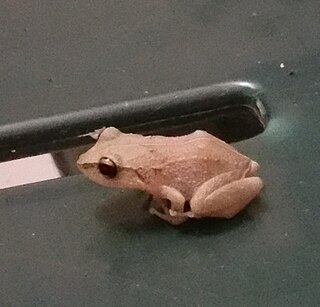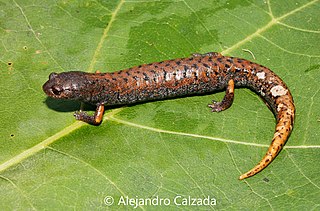
Plectrohyla guatemalensis, also known as the Guatemala spikethumb frog, is a species of frog in the family Hylidae. It occurs in the highlands of the Sierra Madre from southeastern Chiapas, Mexico, and eastward through the central and southwestern highlands of Guatemala to northwestern El Salvador as well as the Sierra de Nombre de Dios in north-central Honduras. It might be a composite of more than one species.

Eleutherodactylus pinchoni is a species of frog in the family Eleutherodactylidae. It is endemic to Guadeloupe and known from the Basse-Terre. Common name Grand Cafe robber frog has been coined for it.
Pristimantis salaputium is a species of frog in the family Craugastoridae. It is endemic to Peru and known from its type locality, the Río Cosñipata Valley, on the northeastern slopes of the Cadena de Paucartambo, a frontal range of the Cordillera Oriental in Cusco Region, and from the Apurímac River valley. Its range might extend into Bolivia. The specific name salaputium is Latin meaning "dwarf" and refers to the small size of this species. Common name river robber frog has been coined for it.

Pristimantis veletis is a species of frogs in the family Craugastoridae. It is endemic to Colombia and is only known from the vicinity of its type locality in Samaná and Pensilvania municipalities in the Caldas Department, on the eastern slope of the Cordillera Central. The specific name veletis is Latin from "skirmisher". It alludes to the resemblance of the color pattern of this frog to the camouflage clothing of the guerillas that were present in the area of the type locality, as well as to the chin pattern that loosely resembles the chevrons in some military uniforms.
The Guaramacal salamander, also known as the holy-mountain salamander, is a species of salamander in the family Plethodontidae. It is endemic to the Cordillera de Mérida, Venezuela. The Venezuelan specimen first reported as Bolitoglossa savagei likely represents this species. The species is named after its type locality, Guaramacal in the Trujillo.
Hartweg's climbing salamander, also known as Hartweg's mushroomtongue salamander, and Hartweg's salamander, is a species of salamander in the family Plethodontidae. It is found in the north-central Chiapas, Mexico, and the adjacent Guatemalan Sierra de los Cuchumatanes.
Bolitoglossa oresbia is a species of salamander in the family Plethodontidae. It is endemic to Honduras and is known from the summit of Cerro El Zarciadero and the southwestern side of the nearby Cerro Azul Meámbar National Park, in the northern Comayagua Department.
The northern banana salamander, also known as common dwarf salamander or rufescent salamander, is a species of salamander in the family Plethodontidae. It is found in the Atlantic slopes of Meso-America from San Luis Potosi, Veracruz, and northern Chiapas in Mexico continuing on to the southern part of Guatemala, Belize, and northern Honduras. However, its range south of Mexico is uncertain because the records may refer to other species.

Savage's salamander, also known as Savage's mushroomtongue salamander, is a species of salamander in the family Plethodontidae. It is endemic to the Sierra Nevada de Santa Marta in northern Colombia. The record from Venezuela represents another species, likely Bolitoglossa guaramacalensis. The species is named after Jay M. Savage, an American herpetologist.
Bradytriton is a monotypic genus of salamanders in the family Plethodontidae. it is represented by the species Bradytriton silus, commonly known as the Finca Chiblac salamander, and has been considered the sister taxon of the genus Oedipina. It is found in north-western Guatemala and in Chiapas, south-eastern Mexico.
The Sierra Juarez hidden salamander, also known as the Sierra Juarez moss salamander, or simply Sierra Juarez salamander, is a species of salamander in the family Plethodontidae. It is endemic to the Caribbean slopes of the Sierra de Juarez and Sierra Mazateca, Oaxaca, Mexico.
Cryptotriton monzoni is a species of salamander in the family Plethodontidae. It is endemic to Guatemala and known only from near its type locality, Cerro del Mono near La Unión, Zacapa Department. The specific name monzoni honors José Monzón, a Guatemalan entomologist who helped the authors with the fieldwork. Common name Monzon's hidden salamander has been coined for it.
Cortes salamander is a species of salamander in the family Plethodontidae. It is found in the Sierra de Omoa in northwestern Honduras and Sierra de Caral in eastern Guatemala, close to the border with Honduras. The vernacular name Cortes salamander refers to the Cortés Department where the type locality is located, whereas the alternative name Cortez' hidden salamander with the spelling "Cortez" and the apostrophe are errors.
Dendrotriton megarhinus, also known as the longnose bromeliad salamander or long-nosed bromeliad salamander, is a species of salamander in the family Plethodontidae. It is endemic to southwestern Chiapas, Mexico, where it is only known from the Cerro Tres Picos, the type locality.

Dendrotriton rabbi, commonly known as the Guatemalan bromeliad salamander, is a species of salamander in the family Plethodontidae. It is endemic to Guatemala and is known from the Montañas de Cuilco, near the Mexican border, and from the Sierra de los Cuchumatanes. Its range might extend into Mexico.
Dendrotriton xolocalcae, commonly known as the Xolocalca bromeliad salamander or Xolocalco bromeliad salamander, is a species of salamander in the family Plethodontidae. It is endemic to Chiapas, Mexico, and only known from its type locality, Cerro Ovando, at an elevation of about 2,000 m (6,600 ft) asl. The specific name xolocalcae is derived from the Indian name of Cerro Ovando, Xolocalco.
Nototriton brodiei is a species of salamander in the family Plethodontidae. It is endemic to the Sierra del Merendón and known from its type locality, Sierra de Caral in Izabal Department, eastern Guatemala, and from the Cusuco National Park in northwestern Honduras. The specific name brodiei honors Edmund D. Brodie Jr., an American herpetologist. Common name Cerro Pozo de Agua moss salamander has been coined for it.
Pseudoeurycea lynchi, commonly known as the Veracruz green salamander, is a species of salamanders in the family Plethodontidae. It is endemic to the central Sierra Madre Oriental in Veracruz and Puebla states, Mexico.

Pseudoeurycea mystax is a species of salamander in the family Plethodontidae. It is endemic to Mexico and only known from the area of its type locality near Ayutla, Oaxaca. Its common name is mustache false brook salamander or mustached false brook salamander. The specific name refers to the whitish protuberances on the lips that resemble a mustache in the frontal view of the male holotype.
Isthmura naucampatepetl, commonly known as the Cofre de Perote salamander, is a species of salamanders in the family Plethodontidae. It is endemic to the Sierra Madre Oriental in central Veracruz, Mexico, where it is known from between Cofre de Perote and Cerro Volcancillo, a satellite peak of Cofre de Perote.






